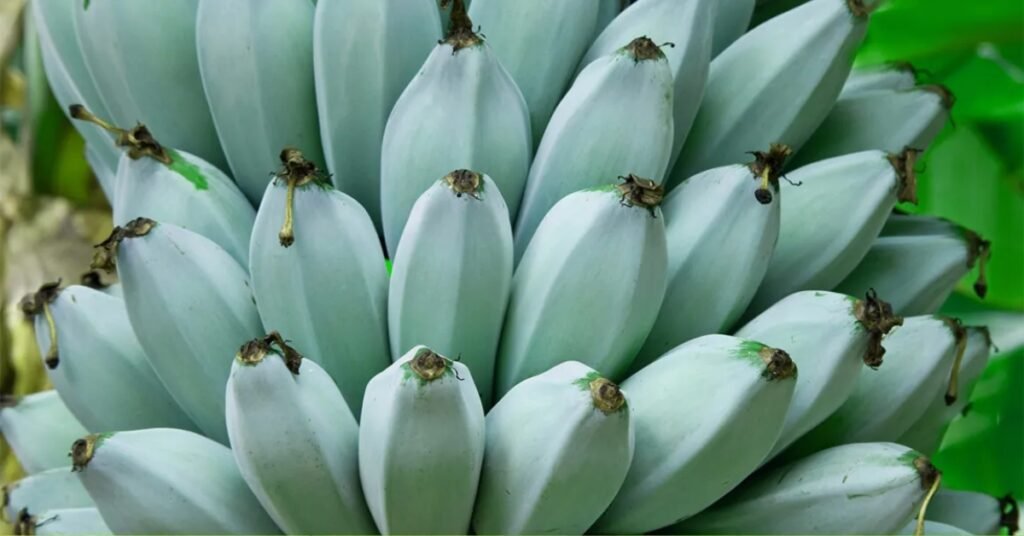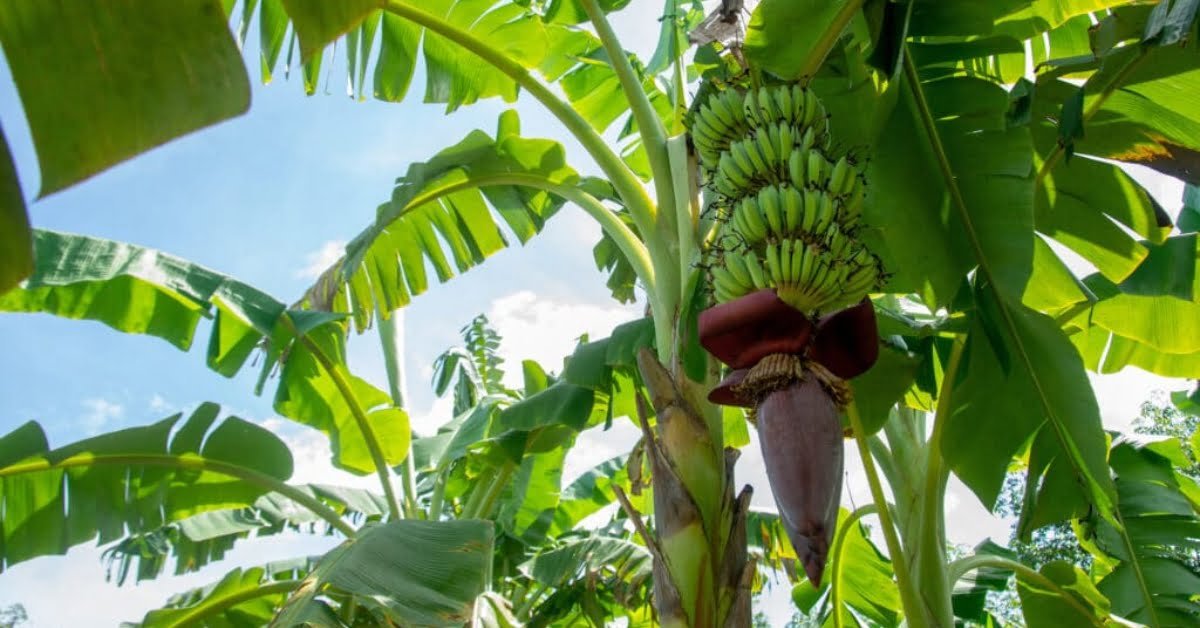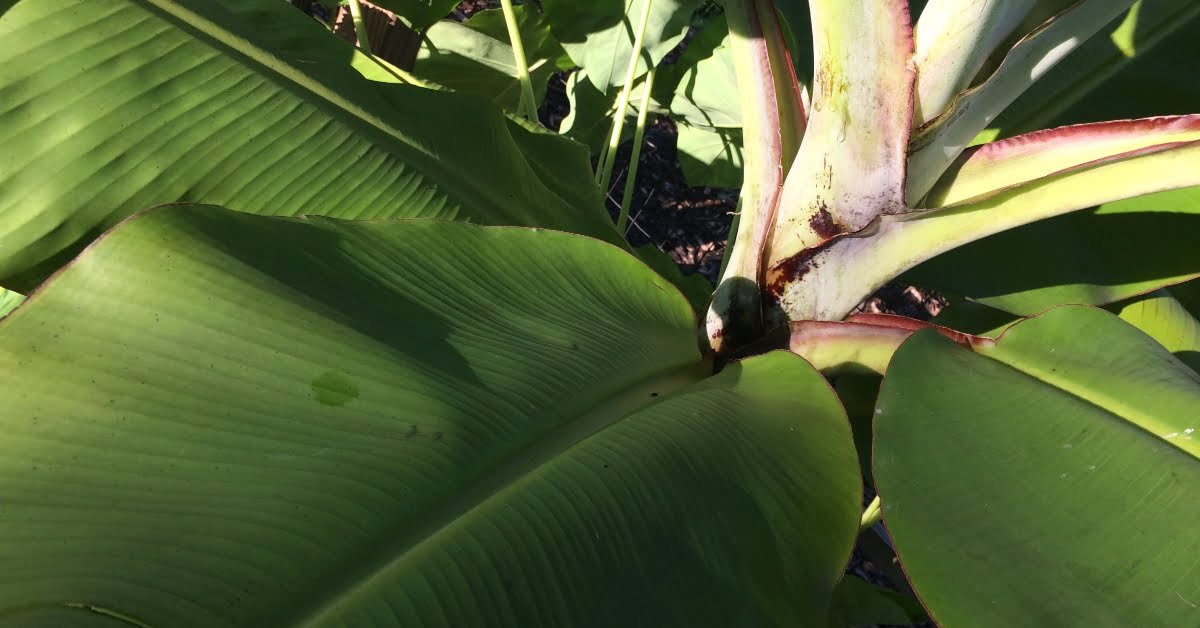The blue java banana, or ice cream banana as it is sometimes called, is an incredible fruit. It looks bluish while still on the plant but ripens to a creamy yellow color and has an exquisite flavor that can be described as tasting like vanilla ice cream – almost too good to be true!
Blue Java Banana
| Common Names or AKA Names: |
|
| Botanical Name: | Musa acuminata × balbisiana |
| Family: | Musaceae |
| Plant Type (Zone 8b): | Indeterminate |
| Hardiness Zones: | Zones 8 through 11 |
| Mature Size: | 15′ – 20′ feet tall |
| Native Area: | Southeast Asia |
| Bloom/Harvest Time: | 115-150 Days From Flowering |
| Sun/Light Exposure: | 8 to 12 hours of Light. |
| Planting Depth: | 1’+ Foot Deep. |
| Soil Preferences: | Dry, Well-Drained & Nutrient-Rich Soil |
| Soil pH: | 5.5 – 7.0 |
| Aquaponically-Friendly: | YES | LEARN MORE |
| Hydroponically-Friendly: | YES | LEARN MORE |
DESCRIPTION:
Slightly gooey in comparison to other banana types, these are rapidly gaining popularity around the world. These plants are a fantastic addition to any food garden, but they’re pretty amazing even if you just want a tropical paradise in your yard. The flower is astounding, and the fact that you get fresh fruit from it so much the better.
The Blue Java banana plant is a hardy, cold-tolerant species, growing to heights of between 15 and 20 feet with strong stems and an excellent root system that helps it resist winds of up to 50 miles per hour. Its silvery green leaves provide a striking contrast against the bright blue fruit which grow in bunches called hands and can reach 9 inches in length.
Blue java bananas are part of the ABB group. They take one set of chromosomes from Musa acuminata and two from Musa balbisiana.
When the blue java banana is about to fruit, it sends up a thick stem called the true stem. This grows through the center of the main stalk and then out, hanging off to one side. It is on this true stem that a single large flower will develop. Each petal will gradually peel back and form a shade for the small collection of banana flowers underneath.
Those are what eventually become the fruit. As they grow, they’re blue bananas, really pretty on the plant. Each hand of ice cream bananas will form under its petal until no more petals open. At this point, the remaining flower can be cut away so that the plant can focus on its fruit.
USE:
Blue Java bananas are popular bananas that can be eaten fresh or cooked. They are known for their fragrant flavor which has a vanilla-like custard taste.
The fruit goes well with ice cream. Blue Java’s are also popular as ornamentals and shade plants for their unusual blue coloration, large size, and tolerance to temperate climates.
Culture & Cultivation:
Blue Java bananas are a favorite among many due to their unique flavor and fragrant aroma that has a custard–like taste, similar to vanilla. They‘re great for eating fresh or cooked, but also make wonderful ornamentals and shade plants because of their striking blue coloration, large size, and ability to withstand temperate climates. Plus they make the perfect topping for ice cream!
Blue Java Bananas, have become increasingly popular in recent years. Native to Indonesia, these unique fruits boast a blueish hue on the outside caused by their higher sugar content when compared to other varieties. The texture and sweet flavor of Blue Java bananas are reminiscent of vanilla ice cream – making them ideal for use in smoothies or milkshakes but also delicious raw or cooked into dishes such as pancakes. Not only do they taste great but Blue Java Bananas contain good levels of potassium, Vitamin C and dietary fiber so you can enjoy this snack without guilt!
Cultivating your own crop requires patience since it takes up to 2-3 years before plants bear fruit after planting from tissue culture methods or suckers found at the base of an existing plant (which will take less time). Planting should occur during warm months with plenty of water provided throughout their growing cycle; however over-watering should be avoided since this could damage root systems resulting in fatal afflictions like Fusarium Wilt or Panama Disease. Once established though maintaining your crop is easy since Blue Jave bananas boast neat growth habits which make caring for them quite manageable even if space is limited . For full maturity expect around 9–10 months until harvestable ripe fruit form on each stem – then just enjoy!
If you want to learn more about cultivating this specific plant, you might want to check out our online courses where we have plant specific mini courses in addition to our standard fully packed courses and master gardening courses.
Planting & Care:
When deciding where to plant your ice cream banana, it is important to choose a site that is as warm and protected from the wind as possible. The ideal soil should be rich, fertile, and well–draining with a pH between 5.5 and 7.0. To propagate any kind of banana tree including ‘Blue Java’, you will need a rhizome removed from the parent plant’s root system which can also be called suckers or pups; look for one that is at least 3′ feet tall in order to get the best results when planting.
When caring for an ice cream banana plant, regular deep watering is key in order to keep the soil hydrated without having standing water – especially during cool weather months when over-watering could potentially kill the rhizomes by rotting them out. Mulch can help regulate moisture levels and protect roots so spread a thick layer of organic material around your new baby! A balanced fertilizer should be applied once per month according to package directions keeping it away from direct contact with the stems on your plants. As they grow you must support their main stem funneling energy into fruiting by trimming off any excess shoots – only after six months can you permit another sucker shoot to start growing in since this will become next season’s stalk following harvest time when last year’s stalk has been cut back and removed completely!
Blue java bananas are incredibly cold tolerant, far exceeding the hardiness of other banana varieties. They can survive temperatures as low as 20 degrees Fahrenheit with the help of a protective wrap – an impressive feat for any fruit!
Blue Java bananas are a low–maintenance plant, making pruning them relatively easy. To keep the plant healthy and robust, remove any weaker pups that form around the base of the adult stalk after it‘s been growing for six months. Additionally, you should only be removing leaves when they have yellowed or browned on their own. If you can‘t easily pull them off without too much force, leave them in place.
Once the adult stalk has produced its true stem and finished fruiting for the season don‘t forget to cut back to corm so that one of the pups can take over for next year’s harvest. Be mindful not to damage any young plants while doing this task! Remember also to use sterilized loppers or pruning shears when performing any type of pruning as this will help reduce chances of transmitting plant diseases.
Growing new plants can be difficult at times but not to worry Green Grass Grove Academy is here to help! We are excited to offer Online Courses on plant care and other Gardening and Homesteading Courses. Our goal is to provide you with the knowledge and skills necessary to become a successful gardener. Our Online Courses are designed to be self-paced and to be completed at your convenience. Courses contain invaluable information to help you become the ultimate Gardener! In addition, Our Courses have entertaining multimedia, quizzes, and a final exam to test your knowledge. Upon completion of each course, you are eligible to receive a certificate of completion. Some of our most popular courses include Aquaponics/Hydroponics, Plant Pathology, Seeds & Seedlings, Microgreens, Plant Mini-Courses, and Insect Pest & Nutrients Management.
So what are you waiting for? Come on over to Green Grass Grove Academy and let us help you become the ULTIMATE GROWER!
Watering:
Bananas love water and thrive best in humid conditions. Be sure to ensure your soil is well–draining, so that it doesn’t pool up around the plant during rain. You can also place a soaker hose around the base for a deep soak. During summertime, water deeply on a daily basis; however in other months, if there has been significant rainfall skip watering or do an every–other–day routine instead. Aim for about 50% humidity to give your blue java the perfect environment!
Harvesting:
Blue Java bananas are a special type of tropical fruit that develop a unique blue tint when ripe. To tell if the fruit is ready for harvesting, look for the bright blue hue to fade away from the banana peel and petals at the end of each hand to become crisp. When it’s time to harvest, have someone help you cut through the stem above your bunch and then carefully lower them down.
Once harvested, these fruits will quickly ripen over time so it’s best to eat them as soon as possible or freeze them for long–term storage. If frozen, simply skin them before storing in an airtight container or mash into a paste which can be used like real ice cream – making it an incredibly delicious natural treat!
The Blue Java banana not only has its own distinct flavor but also provides many health benefits including being high in potassium and fiber while low in calories – making it perfect fuel for those who lead active lifestyles!
Leaf Spot | Panama Disease | Banana Bunchy Top Disease | Banana Mosaic Virus
Take Our Online Insect Pest Management Course to become an expert at dealing with these pests and others too!
Learn More About This Plant!
Can it be grown in aquaponics?
Yes, Blue Java bananas can be grown in aquaponics. They require a warm environment and plenty of nutrients from the water to grow healthy fruit. Aquaponics systems provide an ideal setup for growing these unique fruits with their recirculating flow of nutrient–rich water that is supplied by fish waste. A good balance must be maintained to ensure adequate nutrition for both the plants and the fish. We strongly suggest you take our aquaponics courses to help make you more familiar with growing this unique and precious plant!
Disease Bonus Tips:
Banana plants are susceptible to several types of pests. The most common are banana aphids, spider mites, mealybugs, and two types of thrips– banana rust thrips and corky scab thrips. These all feed on the sap from the fronds or fruit of your plant, making them a nuisance. Neem oil can be used for small outbreaks while pyrethrin is recommended for larger ones.
The coquito beetle also goes after bananas directly by attacking the fruit itself. They can be caught with sticky traps to help prevent further damage to your plant‘s harvestable crop yield. In addition, root knot nematodes may attack the roots of your plant causing significant damage and should be treated with beneficial nematodes as soon as possible in order to prevent any long term issues arising from this pest infestation type issue.
Finally black weevils or banana stalk borers cause major destruction when they burrow their way into stems and trunks – pyrethrin is recommended for large scale elimination of these pests from gardens containing Banana plants as it has proven effective against them in particular cases where other methods have failed priorly.
The information in this post is NOT medical/nutrition advice, as we are not doctors or nutritionists. This information is for informational/entertainment purposes only and is not a substitute for professional medical advice, nutrition advice, diagnosis or treatment. If you have any concerns or questions about your health or nutrition intake, you should always consult with a doctor or other licensed and qualified healthcare professional.
Green Grass Grove Plant Profiles
No posts found!






